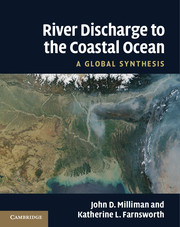Book contents
- Frontmatter
- Contents
- Foreword
- 1 Introduction
- 2 Runoff, erosion, and delivery to the coastal ocean
- 3 Temporal variations
- 4 Human activities and their impacts
- Appendices. Global river data base
- Appendix A North and Central America
- Appendix B South America
- Appendix C Europe
- Appendix D Africa
- Appendix E Eurasia
- Appendix F Asia
- Appendix G Oceania
- References
- Indexes
4 - Human activities and their impacts
Published online by Cambridge University Press: 03 May 2011
- Frontmatter
- Contents
- Foreword
- 1 Introduction
- 2 Runoff, erosion, and delivery to the coastal ocean
- 3 Temporal variations
- 4 Human activities and their impacts
- Appendices. Global river data base
- Appendix A North and Central America
- Appendix B South America
- Appendix C Europe
- Appendix D Africa
- Appendix E Eurasia
- Appendix F Asia
- Appendix G Oceania
- References
- Indexes
Summary
Any water that escapes to the sea is wasted
Josef StalinWhiskey is for drinking; water is for fighting over
Mark TwainIntroduction
By their very nature, rivers have played key roles in human history by helping to determine, feed, extend, and confine the sites of civilization. Renourishment by fluvial waters, their soils and nutrients were necessary for sustainable agriculture. Rivers could both unite and separate, fostering communication and transportation but also serving as boundaries between cities, states, and countries. It is not surprising that the earliest Middle-eastern and Asian civilizations began along the Indus, Tigris–Euphrates and Nile rivers. Using geomorphic and historical evidence, Schumm (2005) argues that much of the political stability in early Egypt can be owed to the lower Nile having a straight, non-meandering course, whereas channel avulsion along the Euphrates may help explain the upheavals and conflicts experienced by the Sumerians. Prior to railroads and automobiles 150 years ago, most major population centers were located on or near rivers. Paris, London, Berlin, Moscow, New York, Shanghai, Bangkok, and Calcutta are only some of the more obvious examples.
With the exception of a few sparsely inhabited areas, such as the high Arctic, few drainage basins have been spared some impact from human activity, a conclusion also reached by Wohl (2006) in her analysis of the human impact on mountainous rivers. One interpretation of the two characters that portray the Chinese word for “river” (jiang) (江) is that they originally represented the characters for “water” and “work”, graphic evidence of the importance that the early Chinese placed on their rivers.
- Type
- Chapter
- Information
- River Discharge to the Coastal OceanA Global Synthesis, pp. 115 - 164Publisher: Cambridge University PressPrint publication year: 2011
- 5
- Cited by



